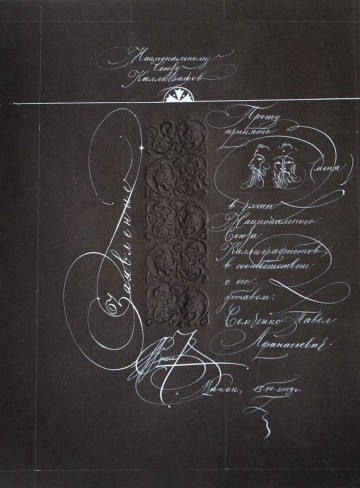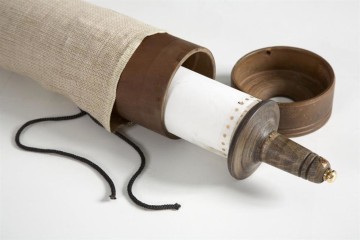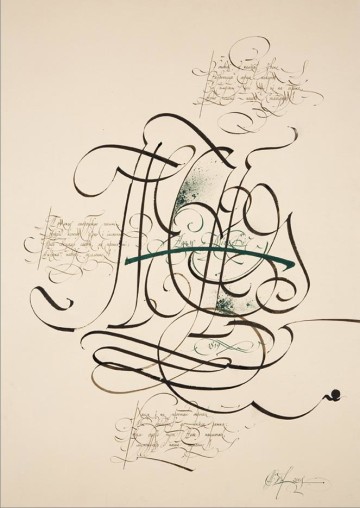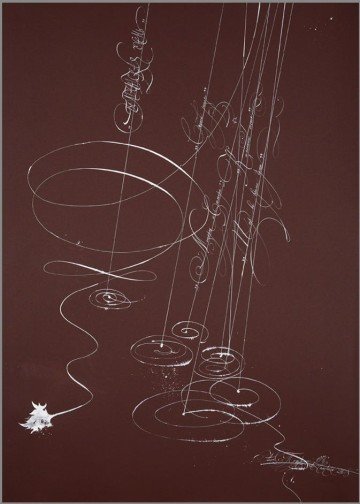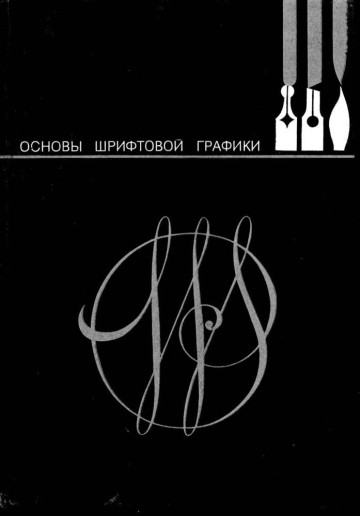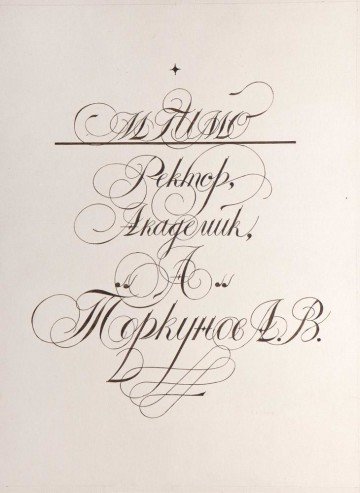谢姆琴科•帕维尔•阿法纳西耶维奇
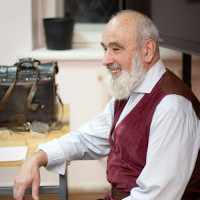
谢姆琴科•帕维尔•阿法纳西耶维奇
明斯克,白俄罗斯
艺术家-书法家,教授,"精神复兴奖”得主
Verbal Narration of Beautiful Writing (Conversation between Grandpa with Grandson)
Amid silence, we hear suddenly…
— Grandpa, Grandpa, let’s talk. You are sitting looking at your strange fountain pen thoughtfully. Did you break it?
— No, I did not. I should sharpen it. The paper started to run to the fountain pen. The fountain pen leaves an unclear trace. It started to scratch.
— And you, Grandpa, continue to learn to write?
— Yes, my Grandson. There is always room for perfection in any task. And it is time only that stops this process. It is important to achieve a level nobody has achieved in one’s business, to be the only one and the first one. If it is yours, it is interesting. A wise man, philosopher G. Skovoroda, explained that: “What is difficult is unnecessary; what is necessary is easy”.
— Grandpa, you are talking simply but unclearly at the same time but I want to listen to you and look at what you are doing. How do you manage to do that so beautifully and mysteriously? You have such a big and strong hand, and the fountain pen is so small and sharp, as a needle – and it makes wonders on paper!
— My grandson, according to physics“ laws, it is a force only that can be transformed into a speed and precision. There is no other way. My hand is big because I did a lot of physical work from my childhood, I like crafts – to plane lumber, to saw, to process metal, to lathe. Do you see the various tools, machinery? They are in order; everything is in its place. When you can do something very well, other things are easy to do. It is scientifically called “skill transfer”. A fountain pen in itself is nothing though it can be beautiful. But if you dip it into ink and make it slide on paper so that it “plays” or “dances” — not everybody can do that.
Here are violin strings – they do not sound themselves, they do not emit sounds without the violin (the deck) — they are nothing more than a piece of thin steel wire. And they sound so melodiously in a master’s hands that you forget everything, you experience some magic. It can speak of many things. It looks customary, ordinary and when the hand of a talented person touches it, a great wonder happens. We notice that when we look at the words of art – painting, graphic art, sculpture, a true calligraphic work; or when we listen to the music, when we admire a dance. In my opinion, no matter what work a person is engaged in, he will seek to make it useful to him, so that it will be beautiful and gladden the heart. But it may only happen when labour becomes a ritual.
— Listen Grandpa, wait a second! Tell me in more detail what do such words as talent and ritual mean? I don’t understand their meaning very well.
— These are foreign words and are rarely used because their meaning is very “high-flown”.
For instance, talent (from the Greek word of talanton meaning “big scales”) is an expression of unusual natural abilities, their constant development and improvement, no matter what the circumstances are. This is to what a person devotes his entire life, what he does better than others.
Abilities are what nature gave you, or what your parents gave to you if they took or take care of that. But it is only the beginning – and then you should work hard to develop these abilities. But it is very difficult to make everything correct and beautiful. The problem is that most people walk, talk and write as they can. The overall culture of the people is at the same level.
— Grandpa! I cannot forget the word “trace” – a trace on paper, on snow. A trace when a sky stone is flying. All of them are traces.
— These are the natural laws that one thing affects others in a certain way. Everything changes and leaves a trace. And a human being, by seeing and hearing, is able to imagine what happened and happens. He studies, compares and analyzes. Therefore, we can say that many traces, many memories accumulate in the human brain. These memories have a special form. What we remember just remotely resembles what our eyes saw and what our ears heard. To understand is a great force. Thanks to memory, a human being accumulates knowledge and is able to use it. He seeks to convey it. A human being started to invent traces/signs so that it will be more convenient to use, transmit and store knowledge. It is in this way he invented the letters we use to convey knowledge or messages or information in general. All of this is studied by very interesting sciences – linguistics, information, semiotics. A human being is similar to animals: they have clever eyes, too. But they cannot assign and resolve a task. They do not have a deep memory. For instance, a dog wants to speak but it immediately forgets what it wants to talk about. Consequently, a human being is a special creature. We make use of different signs, including graphic ones. Thanks to signs, humankind was able to consolidate the mind of human beings – to make it a collective one. If such a brain exists, it is easier to a person and to a nation to find a way out from any situation – but not by any means. As the ancients said: Est modus in rebus (“Be moderate in everything!”).
— Yes! How interesting it is, Grandpa!
— It is so, my Grandson. We have just spoken about learning as something accessible to anybody, elementary and simple. Now we are talking about education. An educated person knows and can do much. It was known long ago that something new appears at the interface between something and something. For instance, let’s take the word “calligraphy” (from the Greek kalligraphi – beautiful and write well). Consequently, one cannot simply speak and write but to do so beautifully. Such person is more perfect. And if he is highly moral, i.e. kind, honest and responsible, we call him an educated person; we say he is well-bred and civilized. This person becomes a special one. With such personality, the person will do his business accordingly. The greater the number of such people in the community the more perfect the community is. A person leading a good life is not settling for but is able to rejoice, to make pleasant surprises, to inspire other people for good causes. But let’s stop talking about that. Let’s speak about what your Grandpa is engaged in and about your interest. Let’s get back a bit.
You, my grandson, are writing and I am writing. Is there a difference? There is a world of difference. It is a difficult topic. Perhaps, we should try to make out what is writing, in a simple form?
— Let’s.
— You can read an answer in a special dictionary but let’s try to formulate the meaning of the word we are interested in ourselves. In general, my experience suggests that to write means to make a linear and graphic form, in one setting, without adjustments, whereas when you draw it is allowed to extend, to cross-hatch, to erase. The word “to trace” is close to the word “to write”. A “trace” is a “line” in the Old Slavonic language. At present, to trace means to make graphic work using drawing devices – a ruler, a divider and a gage. And, for instance, the fountain pen I am holding in my hand and the ball pen you are holding are writing devices. In general, many writing devices were invented for different purposes.
It was written in the definition of the word “to write”: “to write legibly” — it is an important condition that is mandatory at all times and for all nations. And do you know how old the written language is? Don’t you know? It is almost twenty five thousand years old, if we judge by what is preserved on granite rocks, tortoise shells or animal bones. Individual signs are subordinated to certain rules there. Of course, it is a primitive written language. It is made with a chisel or scratched on a solid material. That’s why it is preserved.
And it is quite another pair of shoes when a human being started writing in today’s meaning of this word: at first, on sand, then on clay, later on papyrus and finally on paper. There were many difficult and interesting things in it. People who were able to write, and in particular to write beautifully, were very much respected. They were trusted by gods and rulers. The rest of people worshipped them because penmen knew laws and secrets and were able to record them properly.
A calligrapher should have self-control and rigorous internal organization to fully master his handwriting.
And you my Grandson must be aware of that because you have read about that a lot. Let’s imagine what Vanka Zhukov’s letter to his Grandpa, to the village, looked like. Vanka tried hard but his sad destiny and sufferings made a shadow of letters on a sheet of paper.
The copier/calligrapher Akaki Akakievich, a character of the Great Coat by Gogol, is funnily surprising. Nikolay Gogol describes his endeavors as follows: “There, in that copying, he sees his own diversified and pleasant world. There was delight on his face. Some letters were his favorite ones – if he reached them he was not himself, he chuckled, winked, helped to him with his lips, so that any letter his fountain pen was writing seemed to be readable in his face.”
His personality and the work process are described with great talent. Alexander Pushkin, Nikolay Gogol, Mikhail Lermontov and Ivan Turgenev wrote beautifully in at that time. People were able to express their feelings and emotions with talent in that era. And what about the previous era! The clerical writings – bloomers, Sacred Words, texts, books — were written and adorned diligently. Our first written language was called uncial. Letters were written according to the standard — straightly, legibly and slowly. Then letters were bent. This enabled to speed up their writing. But it was not enough. Civil cursive writing appeared in this way. Cursive writing was improved to achieve geometrical standards, convenience of writing, facility of reading, combining these qualities with the beauty of letters and personal particularities.
Then a typewriter was invented. Now it was possible to write several copies quicker and more legibly at the same time – and to do that identically. The profession of penman started to be replaced. At school, a fountain pen was substituted with a ball pen – a stiff tool that yields the same-thickness boring line. The writing of letters changed, too. They started writing simpler and a bit quicker – but at the expense of ignoring the beauty. There are two negative aspects in it. The first one is that the hand movement plasticity has strongly degraded. And the second one is that the aspiration for the perfection was blunted. There is little beauty in such writing.
— What’s next?
— A new form of writing is on the threshold. To accelerate writing even more, shorthand signs have been developed where consonants are greatly simplified and vowels are designated by elements. This form of writing is imperfect but its speed is equal to the speech speed. Mastering of this form of writing is useful for students to write down lectures.
In my book, Calligrapher’s Melodies, I write that it is the writing of the future. It has not been touched by an artist’s hand. And now I am strongly convinced that it is necessary to teach to write with a fountain pen, with the weight of classical calligraphy, till the second form at school. And later it would be useful to study shorthand. Individual handwriting for ordinary purposes develops independently. But a human being will be equipped with different means of writing and will be able to choose whether he/she should write quickly or beautifully.
— Grandpa, then I write poorly? But my teacher praises me, she says I write neatly and evenly…
— I should be more cautious and considerate to those who teaches you to write and to how they are doing that. You should write not by copying but understanding the meaning of a letter form, by seeing in what sequence one should write. Very many useful things could have been taken from an old ABC book. The beginning is the most complicated and responsible thing in the educational process. One should teach the basics but so that a person will use them for all of his conscious life. It is especially true about school. When they learn to write they should strictly comply with such standards as correct bearing, ability to look, breathe, hold the instrument etc. This is the process that actively influences a pupil’s development. The basis is laid down at that time – the attitude of a future adult to business. Things should be done properly, not just anyhow. At this stage, a child shifts from playful behavior and interest to understanding what is proper, to the shaping of the sense of responsibility for performed work. The sense of personal dignity is formed in healthy competition. If a person has good handwriting it testifies to his neatness, ability to concentrate, to achieve one’s goal, to be able to determine the work quality. It is very important that at this stage a human being be able to do something well — they he/she will treat other forms of studies differently. It is necessary that, while complying with correctness, convenience, legibility and neatness, the trained person got an idea of individual particularities. You should explain what beauty, beautiful line, letter, word and written text are. These are the primary elements of the writing culture. The motor skill, in this case a written skill, is acquired very slowly; it is very important to be guided by the laws of biomechanics here. The plastics of movements of fingers, hand and the entire arm is improved.
Grandson could you please tell me why a person almost identically furls three fingers when he/she prays (in the Orthodox way), holds a spoon or writes? It is a difficult question, isn’t it?
— Yes, it is.
— It is difficult to explain it concisely and easily. So I will mystify you. Not only the head thinks in a human being. Of course, it is the brain that does the bulk of work, but it is not the only thinking organ. Eyes think, too – they even have an open nerve, a continuation of the brain in the form of thin fibers. There is a good expression – an intelligible eye./ In fact, it is easy to say whether an object is closer or farther, bigger or smaller etc. at the eye level. And it is also possible to teach a hand to think and to automatically make certain movements, using nerve fibers and special exercises. It is possible to teach a hand to move quicker, slower, with weight or easier, straightly or in a rounded way. But it takes will and understanding of the purpose. By developing the brain, teaching eyes and hands to think, one can achieve great summits. Being an expert at it, a human being can express himself/herself as a personality. He can show his ideas, feelings, virtual mastery in the form of form of a creative work – it is the sphere of art. When a person sees such calligraphy he/she admires it and how it is made. I say that such laws of art as rhythm, contrast, nuance, and harmony are general. Perhaps it is difficult for you grandson to understand it, but believe my word, I would not make a mistake if I say “musical line”, “musical graphics, minor/major graphic”, “linear countermelody” etc. It is how new things appear, at the interface between linear graphic art and music.
Do you see my Grandson where we plunged – it takes my breath away. This is the sphere of art, and it is only God above. A human being becomes godlike through art in which the elevated, done kind things are firmly established. Talented persons are important for the overall culture of a nation, but the level of overall culture is determined by the number of people who are directly associated in any particular line of business, bring it to the level of art and a creative result. These may be folk crafts or music — and may be calligraphy studies as, for instance, in some Oriental countries. The critical thing is that it should be available and that there will be an inner need for this…
You got silent. Well, think. You are just thirteen. It’s not late to be engaged in something seriously. Yet I started being involved in calligraphy at the age of thirty-three only, and I don’t regret that – it’s mine. Perhaps, this revelation will be useful for somebody else. Some insight is necessary in any business.
And it’s time for me to sharpen my pen and stretch my fingers. I know what to do next.
I believe the square talk of the subject of calligraphy will not end with it. It is but a small portion of something complicated and significant. For self-improvement for a human being is self-analysis, it is labour as a ritual in which the minutest and unexplainable particularities are understood. It is possible if it is yours, if it is your sign under the skies. Express yourself, cheer up and serve others.
And if you started to believe just a bit – you have everything close to you: paper, a fountain pen, ink. Begin a good cause – and let come what may. But never stop.
We confirm we have a direct relation to what is written: Grandpa, Pavel Semchenko, and grandson Taras.
